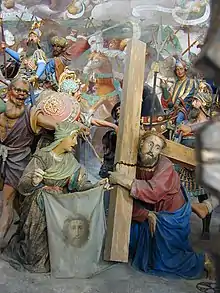
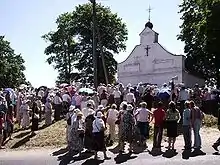

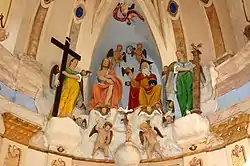

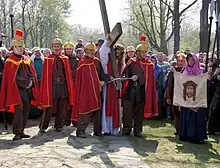
A calvary, also called calvary hill, Sacred Mount, or Sacred Mountain, is a type of Christian sacred place, built on the slopes of a hill, composed by a set of chapels, usually laid out in the form of a pilgrims' way. It is intended to represent the passion of Jesus Christ and takes its name after Calvary, the hill in Jerusalem where Jesus was crucified.
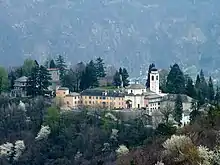
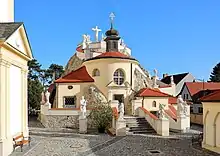
These function as greatly expanded versions of the Stations of the Cross that are usual in Catholic churches, allowing the devout to follow the progress of the stages of the Passion of Christ along the Via Dolorosa in Jerusalem. Each chapel contains a large image of the scene from the Passion it commemorates, sometimes in sculpture, that may be up to life-size. This kind of shrine was especially popular in the Baroque period when the Holy Land was under Turkish rule and it was difficult to make a pilgrimage to the Mount Calvary in Jerusalem.
Calvaries were especially popular with the Franciscan and Jesuit orders, and are most common in Italy and Habsburg Central Europe. They were usually placed in parks near a church or a monastery, typically on a hill which the visitor gradually ascends. Italian ones are usually called a sacro monte ("holy mountain" or "hill"); there are a group of nine Sacri Monti of Piedmont and Lombardy that are especially notable; their dates of foundation vary between 1486 and 1712. Devotions would be most popular in Passion Week, before Easter, when large processions around the stations would be held, and mystery plays might be acted. If a calvary was established in an inhabited place, it might result in a location of a new village or town. Several villages and towns are named after such a complex.
Terminology
The Mount of Calvary was the site outside the gates of Jerusalem where the crucifixion of Christ took place. The scene was replicated around the world in numerous "calvary hills" after the Counter-Reformation and they are used by Roman Catholics in particular as part of their worship and veneration of God.
The term is derived from the Latin translation in the Vulgate of the Aramaic name for original hill, Golgotha, where it was called calvariae locus, Latin for "the place of the skull".[1][2] Martin Luther translated Golgatha as "skull place" (Scheddelstet). This translation is debated; at the very least it is not clear whether it referred to the shape of the hill, its use as a place of execution or burial or refers to something else.[3]
"Calvary hill" today refers to a roughly life-size depiction of the scenes of the Passion of Christ, with sculptures of additional figures. These scenes are set up on the slopes of a hill. The traditional fourteen stations of the cross are usually laid out on the way up to the top of the pilgrimage hill and there is often a small, remote church or chapel located between a few dozen to several hundred metres away.
Calvary hills must not be confused with calvaries, which are a specific type of wayside monumental crucifix, a tradition mostly found in Brittany especially in the Finistère, built in parish closes between 1450 and the 17th century.
- Representative examples
 Multi-figure wayside monument
Multi-figure wayside monument
(Retz) The Calvary Hill in Lend (Graz) around 1830
The Calvary Hill in Lend (Graz) around 1830 Calvary hill and stations of the cross chapel
Calvary hill and stations of the cross chapel
(St. Radegund bei Graz) Shrine with numerous chapels
Shrine with numerous chapels
(Graz) Hill chapel with stations of the cross
Hill chapel with stations of the cross
(Arzl bei Innsbruck) Park-like layout
Park-like layout
(Cvikov) Freely visible landscape monument on the summit
Freely visible landscape monument on the summit
(Calvary hill near Jiřetín pod Jedlovou) Layout at a monastery
Layout at a monastery
(Krastowa Gora)
Calvaries in the world
Austria
Burgenland
- Calvary Hill, Bergkirche in Eisenstadt
- Calvary Hill, Frauenkirchen
- Calvary Hill, Lockenhaus
- in Neusiedl am See
- in Pinkafeld
Carinthia
Lower Austria
- near the Aggsbach Charterhouse in Aggsbach, a village in the Wachau[4]
- in Falkenstein in the wine quarter
- in Kirchberg am Wechsel
- in Lilienfeld, largest calvary hill in Austria
- in Marbach an der Donau
- in Maria-Lanzendorf near Vienna
- in Pillersdorf in the wine quarter
- Calvary Hill, Retz
- in Eggenburg
- in Zwettl
Upper Austria
- Calvary Hill, Aigen in the Mühlkreis
- in Freistadt
- Calvary Hill, Gosau
- Calvary Hill, Kremsmünster
- in St. Martin im Innkreis
- in Schwertberg
Salzburg
- Calvary Hill, Maria Bühel
- Calvary Hill, Maria Plain
- in Oberndorf bei Salzburg
Styria
- Calvary Hill, (Bruck an der Mur)
- Calvary Hill, (Deutschfeistritz)
- Kalvarienberg (Graz)
- Calvary Hill, Leoben[5]
- in Sankt Margarethen bei Knittelfeld
- Calvary Hill (Sankt Radegund bei Graz)
- Calvary Hill, (Feldbach)
Tyrol
- Calvary Hill Chapel, Arzl, in the Innsbruck quarter of Arzl
- in Kufstein
- Calvary Hill, Thaur
Vienna
- in Hernals
Belarus
Belgium
- in Moresnet/Plombières[6]
- in Malmedy
Bolivia
- Cerro Calvario
Canada
Croatia
- Calvary Hill near Aljmaš
Czech Republic
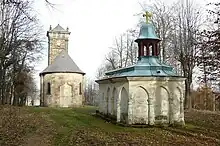
- in Jiřetín pod Jedlovou
- in Cvikov
Ethiopia
England
Mount St Bernard Abbey, Leicestershire.
Germany
- (in alphabetical order by place)
- Calvary Hill, Ahrweiler (with Kalvarienberg Abbey), Ahrweiler, county of Ahrweiler, Rhineland-Palatinate
- Calvary Hill, Aiterbach, Aiterbach, county of Freising, Bavaria
- Calvary Hill Chapel, Altomünster
- in Bad Kissingen
- in Bad Neuenahr-Ahrweiler (as a school)
- in Bad Laer
- in Bad Tölz, Bad Tölz-Wolfratshausen, Bavaria
- in Berchtesgaden
- Calvary Hill, Bergheim, Bergheim, Rhein-Erft-Kreis, North Rhine-Westphalia
- in Bidingen, county of Ostallgäu
- in Birkungen (Thuringia)
- in Burladingen
- in Cham (Upper Palatinate)
- in Donauwörth
- Calvary Hill, Dorweiler, Dorweiler, county of Düren, North Rhine-Westphalia
- in Ebnath in the Oberpfalz
- in Falkenberg (Oberpfalz)
- in Fichtelberg (Oberfranken)
- in Fulda
- in Füssen
- Calvary Hill, Greding, county of Roth, Bavaria
- Calvary Hill, Füssen, county of Ostallgäu, Bavaria
- in Görlitz in the Heiligen-Grab-Ensemble
- Calvary Hill, Gundelsheim, Württemberg
- in Immenstadt
- near the Pilgrimage Church, Allerheiligen in Jettingen-Scheppach
- in the pilgrimage village of Kinzweiler
- Calvary Hill, Kirchenthumbach, Kirchenthumbach, county of Neustadt an der Waldnaab, Bavaria
- (Klosterlechfeld see below)
- in Konnersreuth
- Calvary Hill, Lauterhofen, county of Neumarkt in the Oberpfalz, Bavaria
- in Lenggries
- in Lübeck (Jerusalemsberg)
- in Marsberg
- at Kreuzberg Abbey in the Rhön
- Calvary Hill, Neusath, county of Schwandorf, Bavaria
- in Ostritz, Sachsen
- at St. Marienthal Abbey
- Calvary Hill, Parsberg, county of Neumarkt in the Upper Palatinate, Bavaria
- in Peiting in Upper Bavaria
- in Pfreimd
- in Pillig in Rhineland-Palatinate
- in Pobenhausen and also in Palling, both in Upper Bavaria
- in Possenhofen municipality of Pöcking on Lake Starnberg
- in the Devil's Cave near Pottenstein
- Calvary Hill, Prüm, Eifelkreis Bitburg-Prüm, Rhineland-Palatinate
- Calvary Hill, Alendorf, in the municipality of Blankenheim
- Calvary Hill, Reicholzried
- in Sichtigvor on the Loermund
- in Stühlingen
- Calvary Hill, Schwabegg, county of Augsburg, Bavaria
- in Sonthofen
- in Straelen on the Lower Rhine
- bei Wettenhausen in the municipality of Kammeltal
- in Wenigmünchen (near Munich)
- in Xanten am Niederrhein
- in Zell in the Wiesental chapel on the Möhrenberg
- the Calvary Hill at the pilgrimage site of Klosterlechfeld in Bavaria there is not stations of the cross path, but a monument with outside staircase.
Greece
- on the hill of Filerimos on Rhodes
Hungary
- Calvary Hill in Pécs
Italy
Lithuania

Poland

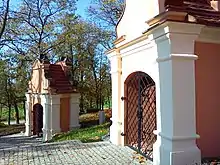
- Kalwaria Zebrzydowska, near Kraków
- Góra Kalwaria, near Warsaw
- Wejherowo, near Gdańsk
- Kalwaria Pacławska, near Przemyśl
- Kalwaria Panewnicka, in Katowice
- Pakość, near Inowrocław
- Góra Świętej Anny, near Opole
- Wambierzyce, near Kłodzko
- Ujście, near Piła
- Krzeszów, near Wałbrzych
- Pszów, near Wodzisław Śląski
- Bardo, near Kłodzko
- Piekary Śląskie, near Bytom
- Głotowo, near Olsztyn
- Wiele, near Chojnice
- Kodeń, near Biała Podlaska
Romania
Slovakia
- Kalvária Banská Štiavnica
- Prešov
- Spišský Jeruzalem
- Bratislava - the oldest calvary in Hungarian kingdom
- Marianka
- Skalica
- Rožňava
- Nitra
- Doľany, Pezinok District[8]
Slovenia
- in Šmarje pri Jelšah
- Kalvarija (Maribor)
Spain
- in Poll ença
See also
References
- ↑ "translation of calvariae by Whitaker's Words". Archived from the original on 2014-02-02. Retrieved 2018-10-07.
- ↑ Bibliotheca Augustana: Hieronimi Vulgata, Evangelium Secondum Lucam, 23:33
- ↑ "Mount Calvary" article in the Catholic Encyclopedia (English)
- ↑ Kalvarienberg neben Kartause Aggsbach, Wachau / Österreich
- ↑ Kalvarienberg in Leoben, Steiermark/Österreich
- ↑ The stations of the cross on the calvary hill in Moresnet / Belgien
- ↑ Kalvarienberg Archived 2018-10-08 at the Wayback Machine auf panoramio.com
- ↑ "Sights". Doľany, Pezinok District. Archived from the original on 11 May 2019. Retrieved 14 April 2020.
Literature
German:
- Atlas der europäischen Heiligen Berge, Kalvarienberge und Devotionsstätten (in German), Turin: Direktion für Tourismus, Sport und Gärten der Region Piemont, 2003
- Walter Brunner (1990), Steirische Kalvarienberge (in German), Graz etc.: Schnider, ISBN 3-900993-02-5
- Elisabeth Roth (1967), Der volkreiche Kalvarienberg in Literatur und Bildkunst des Spätmittelalters (in German) (2nd ed.), Berlin: Erich Schmidt – Philologische Studien und Quellen 2, ISSN 0554-0674
- Louise-Marie Tillet (1989), Reisewege durch die Bretagne. Calvaires und romanische Kirchen (in German), Würzburg: Echter Verlag, ISBN 3-429-01186-8
- Kath. Pfarramt; Maria Himmelfahrt; Johannes Port (1989), Der Kalvarienberg zu Wettenhausen. Gebete und Geschichte einer altehrwürdigen Wallfahrtsstätte (in German), Kammeltal: s. n.
French:
- Yves-Pascal Castel (1997), Croix et calvaires en Bretagne. = Kroaziou ha kalvarihou or bro (in French), Trelevenez: Minihi levenez, ISBN 2-908230-09-7 – also in the Breton language
- Marc Déceneux (2001), La Bretagne des enclos et des calvaires (in French), Rennes: Ouest-France, ISBN 2-7373-2261-8 – Mémoires de l'histoire
- Yannick Pelletier (1996), Les enclos Paroissiaux de Bretagne (in French), Paris: Gisserot – Les universels Gisserot 13, ZDB-ID 2216999-4